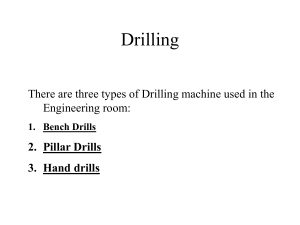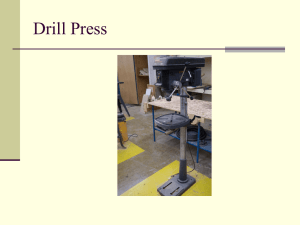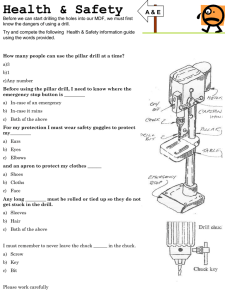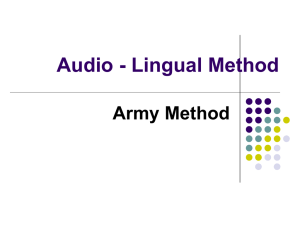Drilling.
advertisement
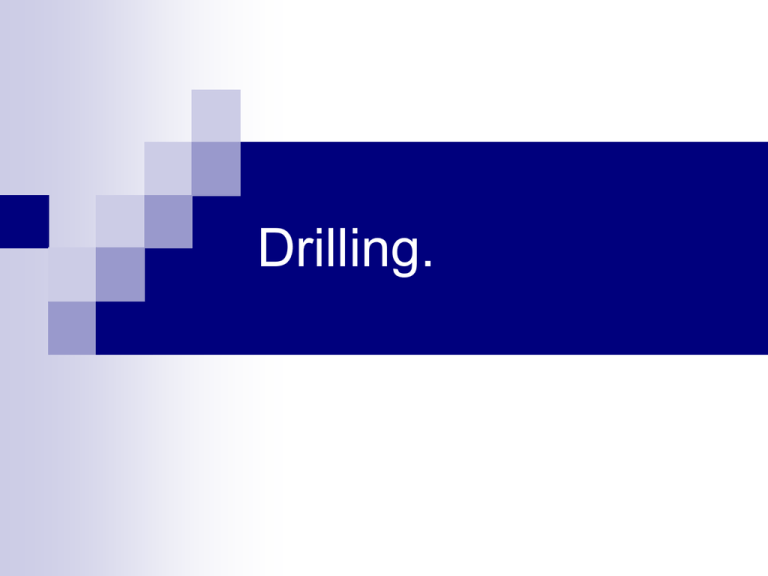
Drilling. The process Drilling is the process of cutting holes in metals by using a drilling machine as shown Drills are the tools used to cut away fine shavings of material as the drill advances in a rotational motion through the material. Belt drive system Belt Motor spindle Feed lever Rack & Pinnion Quill Spindle The twist drill or drill bit Drill Bit The twist drill or drill bit is made from High Speed Steel, tempered to give maximum hardness throughout the parallel cutting portion. Flutes are incorporated to carry away the chips of metal and the outside surface is relieved to produce a cutting edge along the leading side of each flute. Twist drill Twist drills are available with parallel shanks up to 16mm diameter and with taper shanks up to 100mm diameter and are made from high-speed steel. Standard lengths are known as jobber-series twist drills, short drills are known as stub series, and long drills as long series and extra long series. Different helix angles are available for drilling a range of materials Drill Bit Fit in chuck Fit direct into spindle Drill Bit Features Drill Bit Features The point of the drill is ground to an angle of 118 degrees each side is ground back to give " relief " of about 12 degrees to each cutting edge as shown The nomenclature of the twist drill is shown Twist drills - Helix Types The helix angle of the twist drill is the equivalent of the rake angle on other cutting tools and is established during manufacture. The standard helix angle is 30 degrees, which, together with a point angle of 118°, is suitable for drilling steel and cast iron. Helix types Standard slow quick helix Helix types Drills with a helix angle of 20° — known as slowhelix drills — are available with a point angle of 118° for cutting brass and bronze and with a point angle of 90° for cutting plastics materials. Quick-helix drills, with a helix angle of 40° and a point angle of 100°, are suitable for drilling the softer materials such as aluminium alloys and copper Drill Bit Wood bits masonry steel Tool Holding Tool Holding parallel shank drill Drills and similar tools with parallel shanks are held in a drill chuck. By rotating the outer sleeve, the jaws can be opened and closed. To ensure maximum grip, the chuck should be tightened using the correct size of chuck key. This prevents the drill from spinning during use and chewing up the drill shank. Drill bit is only gripped by the shank The Drill Chuck Keyless Chuck Chuck Morse Taper Chuck Key Tool Holding The chuck is fitted with a Morse-taper shank which fits into a corresponding Morse taper in the spindle. The size of Morse taper is identified from smallest to largest by the numbers 1, 2, 3, 4, 5, and 6. The included angle of each taper is different but is very small, being in the region of 3 degrees. If the two mating tapered surfaces are clean and in good condition, this shallow taper is sufficient to provide a drive between the two surfaces. At the end of the taper shank, two fiats are machined, leaving a portion known as the tang. This tang fits in a slot on the inside of the spindle and its main purpose is for the removal of the shank. Drills are also available with Morse-taper shanks which fit directly into the spindle without the need for a chuck. Tool Holding Holding taper shank drills Morse Taper Sleeve Drill Drift To remove a shank from the spindle, a taper key known as a drift is used. Using the drill drift The drift is inserted through a slot in the spindle Strike here to remove Most modern machines have a built-in drift Drilling Processes Typical Drilling Processes Reaming A reamer enters the workpiece axially and enlarges an existing hole to the diameter of the tool. A reamer is a multi-point tool that has many flutes, which may be straight or in a helix. Reaming removes a minimal amount of material and is often performed after drilling to obtain both a more accurate diameter and a smoother internal finish. Countersinking A countersink tool enlarges the top portion of an existing hole to a cone-shaped opening. Countersinking is performed after drilling to provide space for the head of a fastener, such as a screw, to sit flush with the workpiece surface. Common included angles for a countersink include 60, 82, 90, 100, 118, and 120 degrees. Countersinking Bits Counterboring A counterbore tool enlarges the top portion of an existing hole to the diameter of the tool. Counterboring is often performed after drilling to provide space for the head of a fastener, such as a bolt, to sit flush with the workpiece surface. The counterboring tool has a pilot on the end to guide it straight into the existing hole Counterboring Bit Spotfacing Spotfacing provides a seat or flat surface at the entrance and surrounding area of a hole. This flat surface allows the bottom of a screw or bolt to seat squarely with the material. Spotfacing is commonly done on castings where irregular surfaces are found. Spotfacing may be performed on a drill press with a counterbore of suitable size for the operation. A proper size pilot must be used whenever this is done on the drill press. Spotfacing Making a sloped surface flat To seat a nut spotface Back spotface Spotting The holes in the bottom part are transferred by ‘spotting’ through from the top part. Drilling of the bottom part can then proceed in the knowledge that both sets of holes are identical, which may not be the case if both parts are marked out and drilled individually. Drilling holes to depth Holes can be drilled to a particular depth by setting the depth stop on the machine e.g. 15mm Radial Drilling Machine Pistol-grip (corded) drill A drill in the shape of a pistol. Commonly called electric hand drill. Cordless drills A cordless drill is a type of electric drill which uses rechargeable batteries. Hand Drill HOW TO USE A HAND DRILL Drilling sheet metal PROBLEMS… since the chisel edge can break through before the drill is cutting its full diameter, due to the length of the drill point and the thinness of the material. In this case there is no guide at all — the drill will wander and produce a hole to some odd shape. Producing these odd-shaped holes is known as ‘lobing’. Drilling sheet metal PROBLEMS… The same problem arises with ‘snatching’ or ‘grabbing’ — the thinner metal is pushed aside and the drill screws itself through. A further problem associated with this is damage to the metal sheet. A drill pushed with too much force tends to distort the thin sheet initially, rather than cut, and the resulting series of bulges around the holes is obviously unacceptable. These problems can be overcome by supporting the sheet on a piece of unwanted or waste metal plate. The support prevents distortion and the drill point is guided until the hole is drilled through. Drilling Thin Material Support acts as thicker material so drill point is guided through work Drilling plastics problems associated with producing holes in plastics. In general, plastics materials are easily machined using high-speed-steel cutting tools, although some plastics containing abrasive fillers wear out tools very quickly and the use of diamond tools is essential. Thermosetting plastics can be drilled using standard highspeed-steel twist drills. The chips from thermoplastic materials tend to stick and pack the flutes and cause overheating, which can effect the composition of the material. Drilling plastics To prevent this, slow-helix drills with wide highly polished flutes are available. Point thinning can also be carried out to reduce friction and heat at the centre of the drill point. A better finish on breakthrough can be obtained by sharpening the point angle at 90°.. To avoid chipping on breakthrough when drilling the more brittle materials such as Perspex, the material should be held firmly against a solid backing such as a block of hardwood. Use of hardwood prevents damage to the drill point. Large holes in sheet material can be produced using a trepanning tool. Workholding NEVER HOLD WORK BY HAND Drilling Machine Vice The Machine Vice has slots in the side of the base of the vice which enable the user to screw the Machine Vice to the Drilling Machine table. Direct Clamping Clamping set Vee Blocks & Clamps used when drilling round bar Hand Vice used on drilling machine to clamp sheet metal
